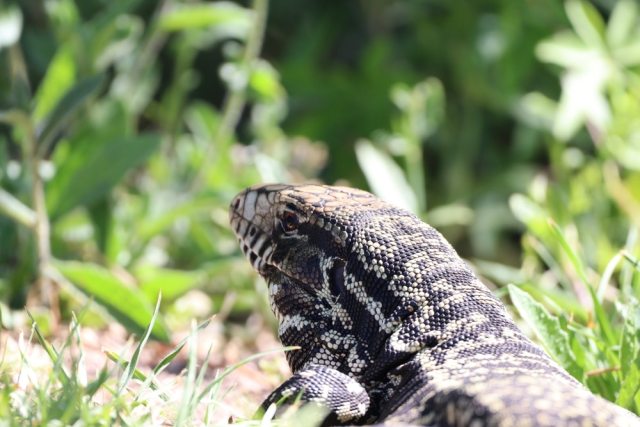
Lighting & UVB for Tegus
Both Argentine and Colombian tegus require 12-14 hours of daily exposure UVB for their health. In captivity, this should be supplemented by opportunities to bask in “real” sunlight as often as weather permits.
UVB
UVB is a form of radiation produced by the sun. All animals produce vitamin D3 via exposure to these rays, including humans (although when we bask in them for too long, we get a sunburn because we don’t have scales to protect us). Vitamin D3 is important for metabolizing calcium. When tegus don’t get enough UVB, they can become D3 deficient, which leads to Metabolic Bone Disease. Although ingesting vitamin D3 in food is often enough to stave off MBD, it’s best practice to use appropriately placed, high-quality UVB lighting instead to reduce the risk of overdose or underdose.
Tegus are classified under Ferguson Zone 3, according to The UV Tool publication by Dr. Frances Baines et al. If you have a Solarmeter 6.5 (recommended), the UVI on the basking surface should be between 3.0-4.0. UVI should be highest at the basking spot and lower in other areas of the enclosure so your lizard has options to choose from.
If you don’t have a Solarmeter, here’s a fair guide to distancing with each bulb type. The given distances are the distance between the lamp and the tegu’s back while standing on the surface closest to the UVB lamp:
- Arcadia T5 HO Desert 12% — 17-21″ / 43-53cm
- Zoo Med T5 HO Reptisun 10.0 — 17-21″ / 43-53cm
- Arcadia T5 HO Dragon 14% — 18-22″ / 45-55cm
Your tegu’s UVB bulb should be 50% of the enclosure’s length, mounted over the basking area with the heat lamps. Use a fixture with a reflector so you don’t accidentally waste any of the UVB — the above measurements are consistent with the Arcadia ProT5 and Vivarium Electronics fixtures.
The above estimations assume that there is no mesh between the tegu and the UVB lamp. If there is some kind of screen present, see the Facebook group Reptile Lighting > Guides > Guide 1: Using T5-HO lamps above a Mesh Screen for recommendations on adjusting basking distance appropriately.
Other Lighting
It takes a lot to light a large enclosure, and a set of heat bulbs plus a UVB bulb isn’t nearly enough to provide the bright light that a diurnal reptile needs for simulating natural sunlight.
The brightest reptile light fixture currently on the market is the Arcadia Jungle Dawn LED Bar. They’re expensive, but the sheer output of bright, beautifully white light makes them worth the investment. I highly recommend installing one or even two in your tegu’s enclosure. Use this to actively light at least half the length of your enclosure.
Tegu Temperatures & Heating
Tegus are cold-blooded, which means that they are dependent on their environment for the warmth that is required for them to be able to move, digest, and carry out other metabolic functions. It also means that they can’t control their internal temperature. If a tegu gets too hot, can’t sweat or pant to cool itself down; instead, it must move out of the heat to cool down. Providing both warm and cool areas in the enclosure is called a temperature gradient.
The ideal temperature gradient for tegus is as follows:
- Basking surface — 125-135°F (52-57°C)
- Warm side — 90-95°F (32-35°C)
- Cool side — 75-85°F (24-29°C)
Make sure to turn off all lighting and heat sources at night to create a nightly drop in temperature down to 68-74°F (20-23°C). Nightly temperature drops facilitate your tegu’s best health by helping them sleep more deeply.
To make sure that you have the right temperature in each area, you will need an infrared temperature gun like the Etekcity Lasergrip 774. These handy tools offer pinpoint temperature readings for anywhere in the enclosure — a true must-have for any reptile owner.
How to heat a tegu enclosure
For hatchling tegus, a high wattage halogen floodlight bulb should provide enough heat to get the basking spot up to temp.
Once your tegu reaches yearling size, you may notice that a single floodlight bulb doesn’t provide a basking spot large enough for the tegu’s entire body. Because yearling and adult tegus are so large, it’s more efficient to use a series of halogen flood lights clustered together, creating a proportionally larger basking zone.
Finding out the right bulb wattage takes some careful experimentation to get right, which is one of the reasons why it’s so important to set up the enclosure well before getting the tegu! Here are some bulbs that work well for creating the basking heat that tegus need:
- Arcadia Halogen Heat Lamp
- Zoo Med Repti Tuff Halogen Heat Lamp
- Philips PAR38 Halogen Flood Bulb
- Sylvania Capsylite PAR38 Halogen Flood Lamp
For a 4′ tall enclosure, you’re likely to need 75-100w bulbs. Optimal wattage often varies in proportion to basking distance and room temperature. Avoid excessive bulb dimming, as dimming can drastically reduce the bulbs’ output of deep-penetrating Infrared A heat.
Place a hide on the cool end of the enclosure to give your tegu a secure place to retreat from the heat. Providing a place where they can dig their own burrow is also an option. (See Substrate Options for Pet Tegus)

“Teddy The Tegu @ OSC” by Michael King is licensed under CC BY 2.0
Tegu Humidity Needs
If you look at tegus’ native habitat, you’ll notice that they are evolved to thrive in a high humidity environment. To replicate this environment in your tegu’s enclosure, strive to hit 70-80% humidity.
You can hit these humidity levels with two tricks:
- Mix water into the substrate until it is uniformly moist (not muddy). Repeat weekly.
- Mist the enclosure daily. Use a 2 gallon pressure sprayer, or better yet, an automatic misting system. Short misting durations multiple times daily tends to be more effective than one long misting 1x/day.
- Provide a cool humid hide box lined with damp sphagnum moss. Humidity levels in this hide should stay between 90-100%, with the moss replaced regularly to prevent mold.
Keep track of your humidity levels with a digital hygrometer— ideally, two of them: one for the warm side (which will be drier), and one for the cool side (which will be wetter). I like the Zoo Med Digital Thermometer/Hygrometer because it also gives me ambient temperature readings for that area.
Although Argentine tegus generally do well enough with a large water bowl, Colombian tegus like to have the opportunity to soak. Use a large but shallow Rubbermaid tub, and keep the water clean at all times. Note that tegus often drag substrate into and even poo in their water, so be prepared to clean and replace the water daily. A Python siphon can make this process much easier, and if the water’s been contaminated with feces, make sure to wipe down the tub with F10SC or Rescue veterinary disinfectant before refilling.
Keep reading about tegu care:
- Introduction to Tegus
- Shopping List
- List of Tegu Species
- Terrarium Sizing for Hatchlings, Juveniles & Adults
- Lighting, Temperature & Humidity Requirements
- Substrate Options
- Decorating Your Tegu’s Enclosure
- Feeding Your Tegu
- Handling Tips
- Benefits of Free-Roaming
- Common Problems & Questions About Tegu Health
- Additional Resources
This page contains affiliate links.
